
CerMark on Food items and Medical Device
Share
We are regularly asked about marking medical devices ranging from surgical tools, instruments and even implants. The following note explains factors that you need to consider when specifying CerMark as a marking solution.
FDA Approval
A common question is “do your products have FDA approval?” CerMark is a coating used in a marking process. FDA approval must be obtained by each medical device manufacture where the process of marking would be considered part of the items manufacturing process. The CerMark coating and marking process otherwise generically referred to as “laser bonding” is not something the FDA can approve by its’ self. We have multiple customers that have used the CerMark laser bonding process and have had their instruments with our marks successfully approved by the FDA.
Permanence of Mark
One of the most important considerations is the permanence of the mark. This will depend on the processes the product is expected to withstand such as cleaning, passivation and multiple sterilization cycles in an autoclave. Among our customer base, we have many people marking surgical tools that have passed different tests such as those listed below:
Passivation – ASTM A967 Citric Corrosion – ASTM A380
Common Applications and Substrates
The most common application we encounter is marking surgical tools. In most cases these will be made from high grade stainless steels. Other common applications include products such as dental equipment that has an anodized aluminum finish. We recommend using our LMM 6000 or LMM14 material for stainless steel and our LMM6018 tape for anodized aluminum.
Laser Bonding versus Direct Laser Marking
Historically, instrument makers have used laser engravers such as YAG or fiber laser based systems to produce black direct marks by heating (annealing) the metal. The settings for this process can be very sensitive and if not done properly can lead to corrosion (rust) of the mark. The CerMark laser bonded mark can be achieved using a lower cost CO2 laser and will offer better protection against corrosion, UV and abrasion than many direct marks.
Customer Testimonial
The testimonial below is feedback from one of our customers on the performance of the CerMark process:
“I would like to mention how pleased we are with the results of the LMM14 marking spray. We use a CO2 laser to mark our stainless steel products used in vascular surgeries…The majority of medical device manufacturers in the industry use YAG lasers to engrave marks onto stainless steel, but through our testing, they would fail 100% due to rusting. I have tested your product against chipping, rubbing, corrosion (ASTM A380), visual inspection and cytotox. Marks using LMM14 passed 100%. Even through Citric Passivation (ASTM A967 Citric) the laser mark would not fade or come off, unlike the YAG mark. The LMM14 outperforms the competition and yields a finer, sharper and smoother mark. CerMark has made it possible for us to use a much less expensive laser marking process”